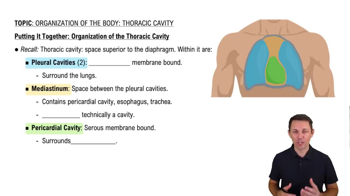Here are the essential concepts you must grasp in order to answer the question correctly.
Pericardium
The pericardium is a double-walled sac that encloses the heart, providing protection and anchoring it within the thoracic cavity. It consists of two main layers: the fibrous pericardium, which is a tough outer layer, and the serous pericardium, which is a thinner inner layer that produces serous fluid to reduce friction during heartbeats.
Recommended video:
Organization of the Thoracic Cavity
Fibrous Pericardium
The fibrous pericardium is the outermost layer of the pericardium, composed of dense connective tissue. It serves to protect the heart, limit its motion, and prevent overexpansion. This layer is firmly attached to the diaphragm and the great vessels, providing structural support and stability to the heart.
Recommended video:
Serous Pericardium
The serous pericardium is the inner layer of the pericardium, consisting of two parts: the parietal layer, which lines the fibrous pericardium, and the visceral layer, which adheres directly to the heart's surface. This layer secretes serous fluid, which lubricates the heart and reduces friction as it beats, facilitating smooth cardiac movement.
Recommended video:
Locations of Serous Membranes
 Elaine N. Marieb, Katja Hoehn 7th Edition
Elaine N. Marieb, Katja Hoehn 7th Edition Ch. 18 The Cardiovascular System: The Heart
Ch. 18 The Cardiovascular System: The Heart Problem 16
Problem 16 Verified step by step guidance
Verified step by step guidance


